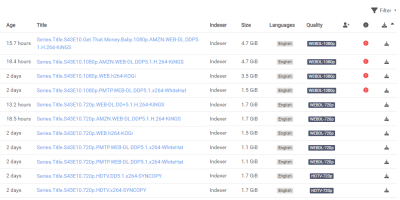
- Install sonarr through python movie#
- Install sonarr through python 1080p#
- Install sonarr through python install#
- Install sonarr through python tv#
- Install sonarr through python download#
Since we manually downloaded the build from the repo, it does not know what version it is. Windows Firewall will again pop its nose into our business, click Allow access. After a second, Headphones will open in your browser. As long as you kept all the default settings while installing Python, you should be able to double-click that file. Now go into that folder and you will see a file called Headphones.py. Once you have that folder extracted, you can rename it to simply headphones.

In my case, that would be C:\Users\foxingworth. In the zip, you will see a single folder titled headphones-master. Click that open the file after downloading.
Install sonarr through python download#
On the right sidebar, you'll see a button that says Download ZIP.

The first thing we are going to do is grab the latest build off of the Github repository. No worries though, just stick with the guide and we'll have you done in no time.

We don't get the benefit of an installer, so we have to do a little more heavy lifting to get it in place. To be perfectly frank, Headphones is a lot less polished than the other two applications. While installing, use all of the default settings. We will be downloading it from, specifically the 64-bit 2.7.8 version.
Install sonarr through python install#
Headphones requires Python 2.7 to run, so we will need to install that first.
Install sonarr through python tv#
Just like we have Sonarr for TV and CouchPotato for movies, we have a program called Headphones to handle our music collection. Now that TV and movies are all taken care of, we move on to the last bit: music. To filter by profile in docker use *ARR_A_PROFILE_FILTER or *ARR_A_PROFILE_FILTER_ID ENV variables.Believe it or not, we are nearing completion on our server.
Install sonarr through python 1080p#
run this script directly or through a Cron: ```bash python index.py ``` - # Docker Compose This script can run through a docker container with a set interval (default every 5 minutes) ```bash syncarr: image: syncarr/syncarr:latest container_name: syncarr restart: unless-stopped environment: RADARR_A_URL: RADARR_A_KEY: XXXXX RADARR_B_URL: RADARR_B_KEY: XXXXX RADARR_B_PROFILE: 1080p RADARR_B_PATH: /data/Movies SYNC_INTERVAL_SECONDS: 300ĭocker run -it -rm -name syncarr -e RADARR_A_URL= -e RADARR_A_KEY=XXXXX -e RADARR_B_URL= -e RADARR_B_KEY=XXXXX -e RADARR_B_PROFILE=1080p -e RADARR_B_PATH=/data/Movies -e SYNC_INTERVAL_SECONDS=300 syncarr/syncarr Notes install the needed python modules (you 'll need pip or you can install the modules manually inside the `requirements.txt` file): ```bash pip install -r requirements.txt ``` 2. **Note** If `sync_bidirectionally` is set to `1`, then instance A will require either `profile_id` or `profile` AND `path` as wellġ.

Sync_bidirectionally = 1 # sync from instance A to B **AND** instance B to A (default 0) auto_search = 0 # search is automatically started on new content - disable by setting to 0 (default 1) skip_missing = 1 # content with missing files are skipped on sync - disable by setting to 0 (default 1) (Radarr only) monitor_new_content = 0 # set to 0 to never monitor new content synced or to 1 to always monitor new content synced (default 1) test_run = 1 # enable test mode - will run through sync program but will not actually sync content (default 0) sync_monitor = 1 # if set to 1 will sync if the content is monitored or not to instance B (default 0) Profile_id = 1 # Syncarr will try to find id from name but you can specify the id directly if you want language = Vietnamese # can set language for new content added (Sonarr) (can set by language_id as well) path = /data/Movies Profile_filter = 1080p # add a filter to only sync contents belonging to this profile (can set by profile_filter_id as well) quality_match = HD- # (Radarr only) regex match to only sync content that matches the set quality (ie if set to 1080p then only movies with matching downloaded quality of 1080p will be synced) tag_filter = Horror # (Sonarr/Radarr) sync movies by tag name (seperate multiple tags by comma (no spaces) ie horror,comedy,action) tag_filter_id = 2 # (Sonarr/Radarr) sync movies by tag id (seperate multiple tags by comma (no spaces) ie 2,3,4) blacklist = movie-name-12,movie-name-43,432534,8e38819d-71be-9e7d-b41d-f1df91b01d3f # comma seperated list of content slugs OR IDs you want to never sync from A to B (no spaces) # the slug is the part of the URL after "/movies/" (for Radarr), "/series/" (for Sonarr), or "/artist/" (for Lidarr) **Note** you cannot have a mix of Radarr, Lidarr, or Sonarr config setups at the same time. Or if you want to sync two Lidarr instances: Or if you want to sync two Sonarr instances:Ĥ.
Install sonarr through python movie#
Path = /data/Movies # if not given will use RadarrA path for each movie - may not be what you want!ģ.


 0 kommentar(er)
0 kommentar(er)
